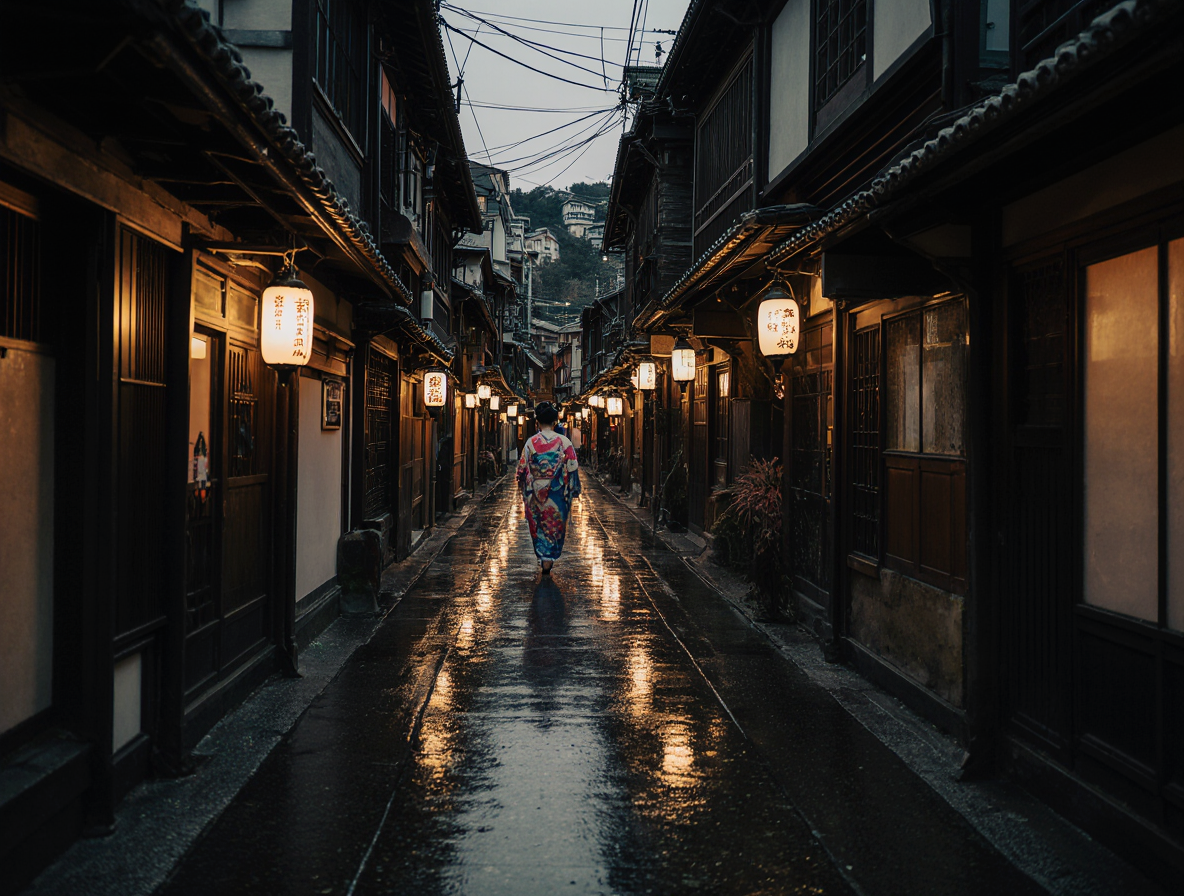A 500-meter alleyway runs parallel to Kyoto’s Kamo River, barely wider than your outstretched arms. Wooden townhouses lean toward each other across stone paths. Lanterns cast amber light after sunset. This is Pontocho—one of five remaining geisha districts where tradition operates as daily business, not museum display.
You won’t find souvenir shops here. Instead, 80 restaurants pack into this narrow strip, serving everything from ¥2,000 yakitori to ¥25,000 kaiseki meals. The challenge? Most places require reservations, display no English signs, and operate according to cultural codes tourists rarely understand.
More about Pontocho:
- Pontocho Park Guided Tours
- Pontocho History: From Sandbar to Entertainment District
- Pontocho Restaurants: Complete Dining Guide
- Kawayuka Platforms: Pontocho’s Summer Riverside Dining Experience
- Geisha and Maiko in Pontocho: Tradition, Etiquette, and Okiya
- Pontocho Location & Nearby Attractions: Your Kyoto Itinerary Hub
- How to Get to Pontocho: Complete Access Guide
- Pontocho Architecture: The Beauty of Traditional Machiya Design
How did Pontocho become Kyoto’s premier dining alley?
Until 1670, this area was an empty riverbank. The Takase River canal project created new land, and merchants immediately filled it with teahouses and entertainment venues. By 1710, Pontocho had formalized as an official geisha district.
The alley’s narrow profile came from tax strategy. Property owners paid taxes based on street frontage, not depth. They built skinny, deep structures—3 meters wide, 30 meters deep—to minimize costs. That shape remains today.
Pontocho could have evolved into a shopping arcade or red-light district. Instead, it maintained focus on upscale dining. The 1923 addition of riverside platforms (yuka) cemented its identity as a summer dining destination. Now that historical development directly impacts your visit: narrow buildings mean limited seating, geisha heritage means referral-only establishments, riverside focus means seasonal pricing swings.
What makes Pontocho different from Gion?
Both are historic geisha districts. The distinction lies in accessibility versus authenticity balance.
Gion’s Hanami-koji Street sees 50,000 daily visitors during peak season. Tour buses park nearby. Shops sell geisha-themed souvenirs. English menus appear everywhere. Pontocho receives one-fifth that traffic despite equal historical significance.
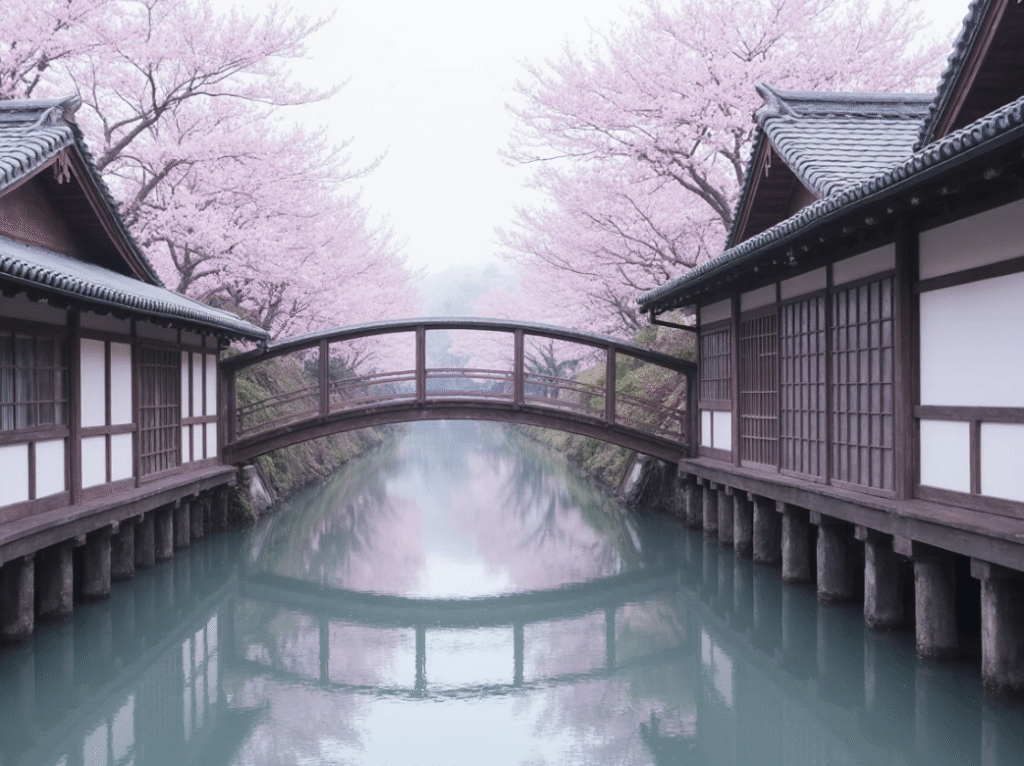
Why? The layout doesn’t accommodate crowds. The alley stays too narrow for buses, too dim for easy photos. Most restaurants skip plastic food displays and English signage. You’ll need to bow at entrances and remove shoes without prompting.
Gion offers a Kyoto atmosphere with tourist infrastructure. Pontocho offers a Kyoto atmosphere where locals actually spend their evenings. Choose based on your comfort level with cultural immersion.
Where is Pontocho and how do you reach it?
The alley runs north-south between Sanjo Street and Shijo Street, one block west of the Kamo River. No official address exists—the Pontocho Association classifies it as private property.
- From Kyoto Station: Karasuma Subway Line to Shijo Station. Five minutes, ¥220. Exit 6, walk east on Shijo for three minutes to Kiyamachi Street. Turn left, walk one block north. The southern entrance appears on your right.
- From Gion: Cross Shijo Bridge westward. After the bridge, turn right onto the first small street. Four minutes walking.
Three entry points exist:
- Southern entrance at Shijo-Kiyamachi (most crowded, 6 PM-8 PM)
- Northern entrance at Sanjo-Kiyamachi (quieter, locals prefer this)
- Mid-point near Rokkaku Street (unmarked, easy to miss)
Use the northern entrance during dinner hours. You’ll avoid crowds and walk with foot traffic flow instead of against it.
Should you visit during the day or evening?
Evening. No debate.
Pontocho is a nightlife district that activates after 5 PM. During daytime, most establishments close or prep for evening service. Atmospheric lighting, lantern glow, crowd energy—none exist before sunset.
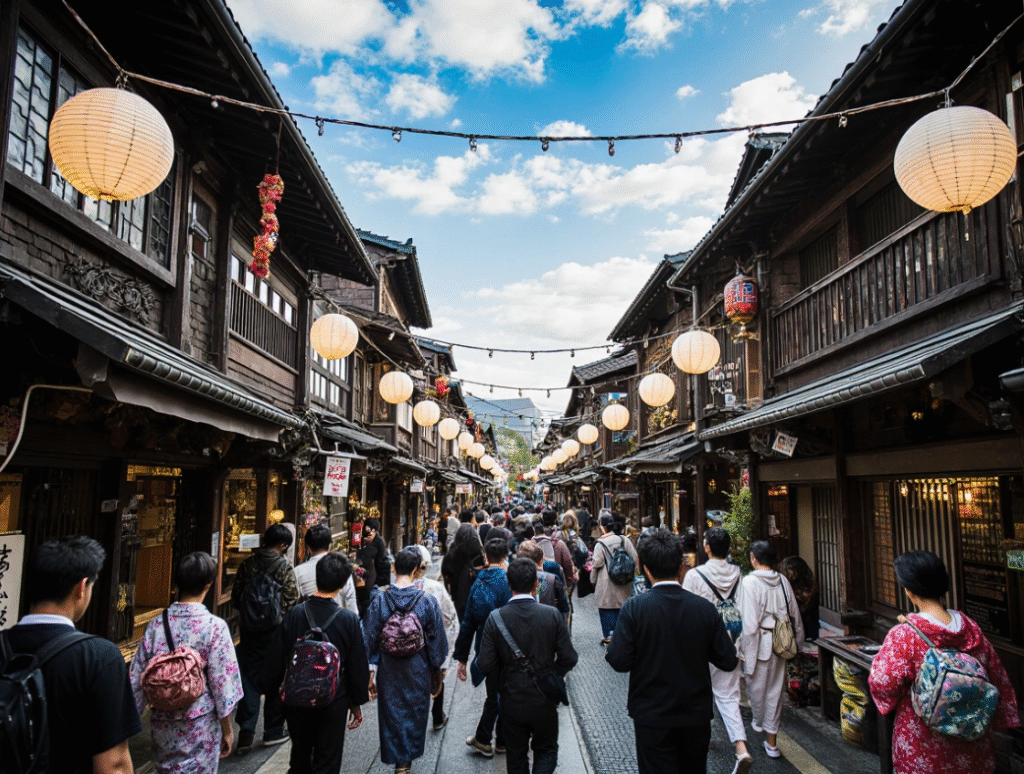
Walking Pontocho at 2 PM versus 7 PM compares to visiting an empty theater versus watching a performance. Same physical space, completely different experience. Restaurant facades look best under lantern light. The narrow alley creates shadow play after dark. Shamisen music flows from second-story windows.
Arrive between 6 PM and 7 PM. Walk the 500-meter length once while restaurants open and staff light lanterns. Have dinner. Walk through again after 8 PM at peak activity. Budget 45-60 minutes for the full experience.
What are the biggest mistakes tourists make here?
Mistake 1: Photographing geiko without understanding protocol
Tourists see a woman in full kimono and traditional hairstyle, then immediately raise cameras. Some block the alley for better angles. Others touch the kimono fabric.
The problem: Geiko are professionals going to work, not tourist attractions. These women earn ¥30,000-50,000 per evening appointment. Blocking their path makes them late, damaging their reputation with clients.
Local Kyoto residents actively intervene when tourists harass geiko. You might face public confrontation. Many geiko now travel by taxi instead of walking, reducing sightings by 40% over five years.
The cost: You damage cultural heritage, risk embarrassment, and contribute to tradition-altering problems. Want geiko photos? Attend Kamogawa Odori performance in May (tickets ¥5,000-6,000) where photography is permitted, or book private maiko experiences (¥30,000-50,000 per group).
Mistake 2: Visiting without reservations and expecting walk-in dining
Most quality restaurants require reservations days or weeks ahead. Casual places accepting walk-ins have 30-40 minute waits between 6 PM and 8 PM. Kyoto has 5,000 other restaurants. Many serve identical food with zero wait.
Mistake 3: Booking accommodation near Pontocho for “authentic Kyoto”
Pontocho sits in Kyoto’s entertainment district, not its cultural center. Surrounding blocks contain karaoke bars, nightclubs, chain restaurants. After 10 PM, drunk crowds fill sidewalks. Street noise penetrates windows until 2 AM, especially weekends.
Meanwhile, actual historical sites sit elsewhere. Kinkaku-ji takes 30 minutes by bus. Fushimi Inari requires 15 minutes by train. You’ll spend ¥2,000-3,000 daily on transportation, 90-120 minutes in transit, plus nights in a noisy area that doesn’t represent traditional Kyoto.
Better positioning: Book near Kyoto Station for transport access, or Higashiyama near Kiyomizu-dera for actual historic atmosphere.
How do you choose a restaurant?
Roughly 80 establishments pack into 500 meters. No directory exists. No central reservations. Most lack English signage.
Price tiers:
- Budget (¥2,000-4,000): Yakitori spots, standing bars, basic izakaya
- Mid-range (¥4,000-8,000): Full-service izakaya, decent kaiseki, Italian restaurants
- Premium (¥8,000-15,000): Established kaiseki, riverside dining
- Luxury (¥15,000+): Historic ochaya-affiliated restaurants, private rooms
Reservation strategy by timeline:
4+ weeks out: Contact your hotel concierge. Request riverside platform reservation at mid-range kaiseki. Provide 3-4 possible dates. Concierges access reservations unavailable on booking platforms.
1-2 weeks out: Use TableCheck or Tabelog for indoor seating. Focus on places with 20+ reviews, ratings above 3.5. Book off-peak times (5 PM-6 PM or after 8:30 PM).
2-3 days out: Plan walk-in dining at casual spots near the northern end. Arrive before 5:30 PM or after 9 PM. Expect 30-minute queues during peak hours.
“Foreign tourists ask if geiko entertainment is ‘worth it.’ That question misunderstands everything. Geiko entertainment isn’t a show you watch. It’s refined conversation and artistic appreciation that requires years of context. A single evening means nothing without background. Most Kyoto businessmen spend years building ochaya relationships before they understand what they’re experiencing. Tourists expecting concert-like entertainment inevitably feel disappointed.”
Insight from Takeshi Yamamoto, 4th-generation Pontocho restaurant owner
What should you order?
Pontocho doesn’t have signature dishes unique to the alley, but certain preparations appear frequently due to riverside tradition and kaiseki concentration.
- Ayu (sweetfish): Summer menus, June-August. Grilled whole over charcoal with salt. ¥1,500-2,500 per fish.
- Hamo (pike conger eel): Kyoto summer specialty. Bone-cut into thin slices, boiled, served with plum sauce. Requires expert knife skills—the fish has 3,000+ small bones. ¥2,500-4,000 per portion.
- Yakitori: Grilled chicken skewers. Pontocho spots specialize in uncommon cuts: tsukune (meatball), hatsu (heart), kawa (skin). ¥150-400 per skewer. Order 5-8 skewers plus rice and miso soup for a full meal.
- Obanzai: Home-style Kyoto cooking. Multiple small plates showcasing seasonal vegetables, tofu, fish. Sets with 5-7 items cost ¥2,500-4,000.
Drink ordering: Most places expect alcohol orders even from light drinkers. Beer (nama biiru) always works. Sake comes in tokkuri (ceramic carafe) serving 2-3 cups, costing ¥600-1,200. Whisky highballs run ¥400-700.
Understanding riverside platform dining
Between May 1 and September 30, restaurants along Pontocho’s east side install yuka—elevated wooden platforms over the Kamo River. These platforms sit 2-3 meters above water on stilts, extending 5 meters from buildings.
Temperature on platforms runs 3-5°C cooler than street level thanks to river breeze. This matters when Kyoto’s summer humidity pushes the heat index above 35°C.
Platform costs and rules:
- 20-40% surcharge versus indoor dining
- Minimum 2-person parties (solo diners typically can’t book)
- Reservations needed 2-4 weeks ahead for weekends
- Some establishments add ¥1,000-2,000 per person “platform fee”
- Season runs exactly four months regardless of weather
Early May evenings around 18°C require jackets. Late June through mid-July brings rainy season—platforms close during downpours but reopen after rain stops.
Think of platform dining like getting a restaurant’s best patio table, except the patio exists only four months yearly and costs as much as a significant meal upgrade.
Who should skip Pontocho?
This alley discourages certain travel styles. Better to know upfront.
- Budget travelers face genuine barriers. Basic dinner starts around ¥3,500 per person before drinks. Riverside platforms begin at ¥6,000. Kaiseki runs ¥10,000-25,000. No chain restaurants, no ¥500 ramen shops. If you’re eating for under ¥1,000 per meal throughout Japan, this district prices you out.
- Families with young children face practical problems. Steep stairs to second-floor dining rooms, no elevators, tatami seating requiring 1-2 hours on the floor. Children running in narrow alleys create safety issues. The refined atmosphere doesn’t accommodate loud activity.
- Non-Japanese speakers encounter communication barriers. Perhaps 20% of establishments have English menus. Maybe 10% have functional English-speaking staff. Many operate omakase (chef’s choice) without customization. Dietary restrictions beyond vegetarianism become difficult to communicate.
The counterargument: If you budget ¥8,000-12,000 per person for one special dinner, make hotel-arranged reservations, and approach it as a cultural experience rather than just a meal, Pontocho delivers something unreplicable elsewhere in Japan.
Comparing your options
| Feature | Pontocho | Gion | Nishiki Market |
| Best Time | Evening (6-9 PM) | Early morning or evening | Daytime (11 AM-4 PM) |
| Tourist Density | Moderate | Very High | Very High |
| Average Meal | ¥4,000-8,000 | ¥3,000-6,000 | ¥1,000-2,000 |
| Reservations | Usually required | Sometimes needed | Not needed |
| English Support | Low (20%) | Moderate (40%) | Moderate (50%) |
| Authentic Atmosphere | Very High | High but commercial | Medium |
Behind the scenes: Cultural codes that matter
Remove shoes at the entrance without being told. Don’t step on the raised threshold with shoes. Place shoes neatly pointing toward the door.
Wait to be seated. Don’t choose your own table. In traditional establishments, hostesses assign seating based on group size and timing.
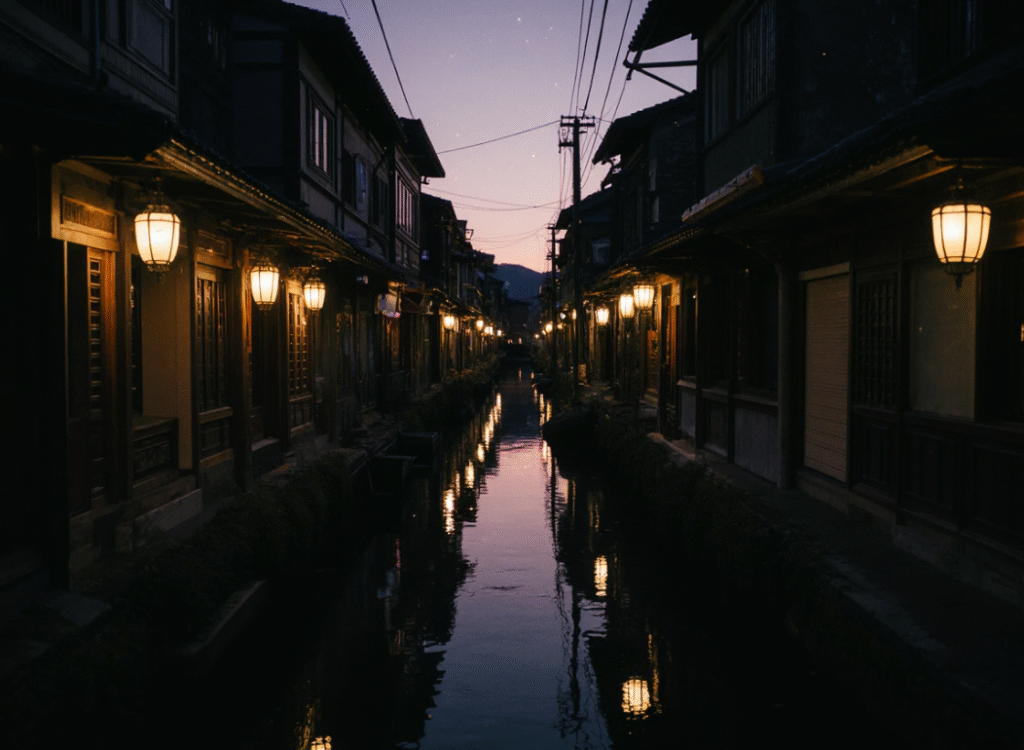
Speak quietly. Volume should stay low enough that adjacent tables can’t follow your conversation. Loud talk disrupts the atmosphere and shows cultural ignorance.
Don’t photograph inside without permission. Some places prohibit photos entirely for customer privacy.
Don’t linger after finishing. Table turnover matters in small restaurants. If others finish and leave within 15-20 minutes after their last dish, you should too.
Local secrets: What guidebooks miss
- The platform system operates under strict regulations. Each restaurant pays annual platform fees to the Pontocho Association (¥150,000-300,000 depending on size). Installation happens during one week in late April. Removal occurs during one week in late September. The Kamo River itself is public property managed by Kyoto Prefecture, requiring separate permits.
- Foreign investment faces significant barriers. The Pontocho Association rarely approves ownership transfers to non-Japanese entities. This keeps chain restaurants out despite high real estate values. When longtime restaurants close, the association seeks similar replacement businesses rather than allowing business type changes.
- Geiko sight timing is predictable. Between 5:30 PM and 6:30 PM, maiko travel from lodgings to evening appointments. Highest concentration walks between Pontocho Kaburenjo Theater and mid-section near Sanjo Street. They move quickly with attendants and stop only for established photographers they recognize.
- The alley’s width varies from 3 meters to 2.3 meters. This inconsistency resulted from 17th-century land disputes never fully resolved. Narrowest sections create bottlenecks 7 PM-9 PM Friday and Saturday, when you’ll move single-file.
“The difference between seeing geiko in Pontocho versus Gion is dramatic. In Gion, you’re competing with 200 tourists with cameras. In Pontocho, you might be the only foreigner present. But here’s the reality: Pontocho’s geiko work—they’re not attractions. If you block their path, locals intervene. Stand aside, bow slightly if you make eye contact, never touch their kimono. That respect gets you a genuine smile instead of a practiced public face.”
Insight from Sarah Mitchell, Kyoto Cultural Liaison
What does a Pontocho visit actually cost?
- Budget scenario: Yakitori dinner ¥2,500-3,500 + 2 drinks ¥600-1,200 + subway ¥440 = ¥3,540-5,140 per person
- Mid-range scenario: Indoor kaiseki ¥4,500-6,500 + drinks ¥900-1,800 + subway ¥440 = ¥5,840-8,740 per person
- Premium scenario: Riverside platform ¥8,000-12,000 + drinks ¥1,500-2,500 + subway ¥440 = ¥9,940-14,940 per person
For couples, a mid-range evening costs ¥12,000-18,000 total. Premium platform dinner runs ¥20,000-30,000. That’s $150-230 USD.
Compare: Non-Pontocho nice dinner costs ¥3,000-5,000 per person. Temple admission runs ¥300-600. Day trip to Nara costs ¥2,000-3,000 including transport and lunch.
Pontocho represents one of your most expensive Kyoto activities outside accommodation. The question isn’t whether it’s “worth it”—that’s subjective. The question is whether you’d rather spend ¥15,000-25,000 on one atmospheric dinner or allocate that money to 3-4 other experiences.
Should Pontocho be on your itinerary?
This alley delivers one specific thing: walking through a historic entertainment district where traditional architecture, refined dining culture, and geisha heritage combine in concentrated space.
- Include it if: You’re spending 3+ days in Kyoto with dining budget accommodating ¥5,000-12,000 per person. You’re interested in Japanese dining culture beyond basic sustenance. You’ve made advance reservations through your hotel.
- Skip it if: You’re traveling on under ¥3,000 daily food budget. You prefer casual spontaneous dining. You have mobility limitations making stairs and narrow spaces difficult. You’re visiting Kyoto for fewer than two days and would rather maximize temple visits.
The travelers who enjoy Pontocho most arrive with appropriate expectations and proper reservations. They come for total experience rather than individual components. They understand they’re paying for atmosphere, cultural access, and refined service alongside their meal.
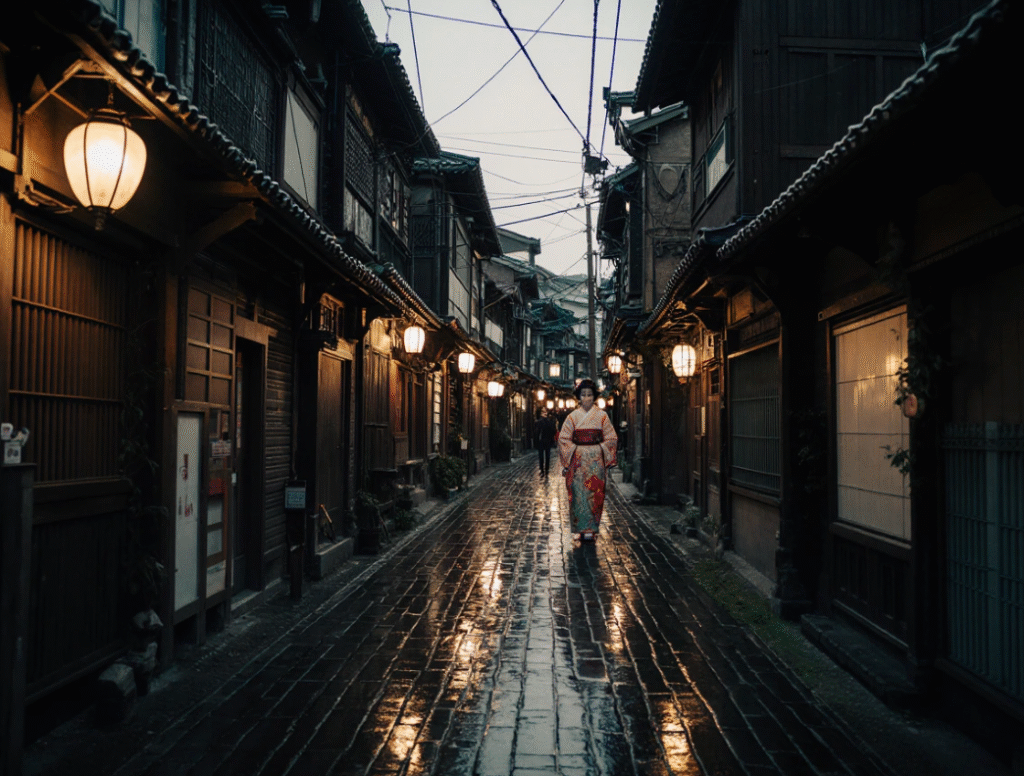
Those who leave disappointed usually expected something different: cheaper prices, easier access, more obvious entertainment value. They compared Pontocho to home country restaurant districts rather than accepting it on its own terms.
Your Pontocho experience depends on what you bring—preparation, appropriate expectations, cultural respect, and willingness to engage with Japanese dining customs. The alley provides the setting. The quality of your visit depends on you.For more detailed information on Kyoto’s dining culture and reservation systems, consult the Kyoto Tourism Association (https://kyoto.travel) and Japan Guide’s restaurant section (https://www.japan-guide.com). For current Pontocho event schedules including the annual Kamogawa Odori performance, check the official Pontocho Kaburenjo Theater website.
